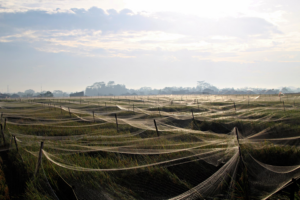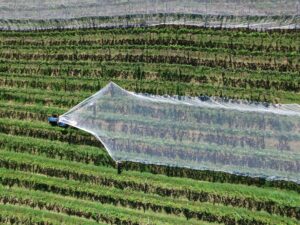Citrus Production: In this editorial some important and available information on shade nets is combined in an attempt to provide citrus producers some background on the use of shade nets in a South African context.
Benefits of Shade Nets

Shade netting could provide significant solutions to fruit-quality-related problems and increase producer competences. Production is somewhat higher than under bright ones (white and transparent) shade net.
The use of non-permanent drape nets is also popular among Israeli citrus producers for protecting fruit against hailstorms in late autumn and early winter (personal correspondence, Dr. Avi Sadka), as well as in California and Australia to restrict cross-pollination and development of seeds in mandarin cultivars, specifically.
Cost Considerations and Potential Drawbacks
The cost comparison between permanent and drape nets favours the use of drape nets, as the lifetime of the nets is longer, with no costs for poles, cables and so forth. However, there are some worrying questions on the coverage and efficacy of medium and full-cover foliar fungicide and insecticide sprays, as well as the effects of drape nets on fruit set, considering that Foliar GA3 sprays may also be impacted.

Wind damage due to abrasion between drape nets and outside fruit could also reduce the benefits under drape nets, if they remain on the trees after petal fall.
Research and Practical Gaps in South Africa
Although the use of shade nets is rapidly expanding in the various South Africa citrus production areas, many critical research questions on the effects of shade nets on tree physiology and fruit quality are unanswered and require urgent attention.
Also, many practical issues regarding production logistics and management of orchards under nets are neglected in some instances. Visits to various citrus producers making use of shade nets to find out their first-hand experiences on the effects of shade nets on citrus production.
Experiences of Producers
A producer in the Northern cape planted 35 hectares of ‘Nadorcott’ mandarin trees a few years ago – 12.5 ha under permanent 20% white nets and 12.5 ha outside. During spring and summer, they struggled with very strong winds and were forced to consider erecting permanent netting structures over some of their new plantings of high-value cultivars. Young trees under nets became almost double in size, compared to those outside.

Conclusion
What to plant, where, and how to optimally apply which technologies will be of critical importance. To avoid exposure to the future threats of climate change and increased competition in the markets, producers should reconsider. Shade nets could provide significant benefits against these threats, but much practical information and answers to critical research.
A co-funded project between the Department of Science and Technology (DST) and Citrus Research International (CRI) in the Research for Citrus Exports programme is underway (See photo5) to answer questions related to the impact of shade nets on the various aspects of citrus production, in order for producers to make informed and sound choices in the near future.

